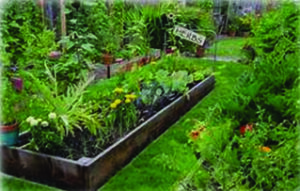By Debbie Roland and
Emmy Ulmschneider
Master Gardeners
The basic principle of regenerative gardening is restoring and maintaining soil health. Modern gardening and agriculture have damaged our soil by the use of pesticides and manual tilling. Additionally, soil animals, fungi and bacteria are harmed by overplanting which causes the depletion of nutrients in the soil.
Regenerative gardening focuses on non-invasive practices that regenerate your soil. Gardeners of all levels can help restore soil health.

Many contemporary gardens rely on fertilizers, pesticides, and other soil amendments. This is the exact opposite of what regenerative gardening aims to do. Here are some tips for regenerative gardening:
1. Minimal Tilling. Are you surprised to know that tilling is one of the practices that regenerative gardeners don’t use? If you look at a freshly tilled garden which is now no longer weedy and compacted, you might think it is a great improvement. However, on a microscopic level it breaks up important fungal colonies as well as increasing soil erosion and water runoff.
2. Organic Fertilizer. This gardening technique does not mean ditching fertilizer all together. It just means using organic ones like compost which is simply decomposed material found in our ecosystem. Organic matter is organic matter, whether it is homemade compost, chicken coop litter or fall leaves. carbon in the soil which is a win-win for life on Earth.
3. Multi-Species Planting. Each plant has its own nutritional requirements. So if you plant a single species over a large area some nutrients are consumed at a higher rate. This practice also eliminates habitats and food sources for wildlife. Planting different species of plants eliminates this and helps preserve the ecosystem. The more plants you have, the less weeds you will have. Also it is hard for pathogens to jump from plant to plant when they are different species.
4. Cover Crops. Cover crops are easy and reap incredible benefits. Think of it as a living mulch. They maintain soil health during times of nonuse. I know you are thinking that only farmers use cover crops. They can easily be used in your garden and beds as well. Examples are clover and even peas. Turn them back into the soil before they seed and your soil will love you. Remember, the more organic matter that is in your soil the more water it will retain.
Regenerative gardening can be time consuming. That is why tillers and commercial fertilizers are so popular. But for those of us who are gardeners at heart the payoff is well worth it. Small changes can make a big difference. Begin by top dressing your existing beds with compost and by covering as much soil as you can with native plants.
For more information, call the AgriLife office at 498-4071 in Odessa or at 686-4700 in Midland or visit aggie-horticulture.tamu.edu or westtexasgardening.org.




